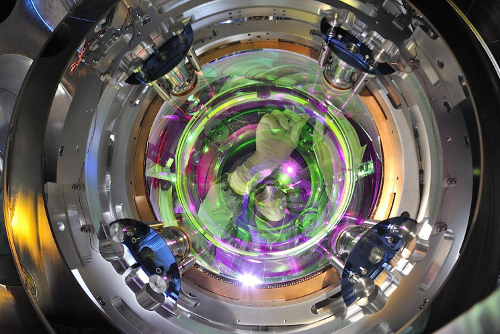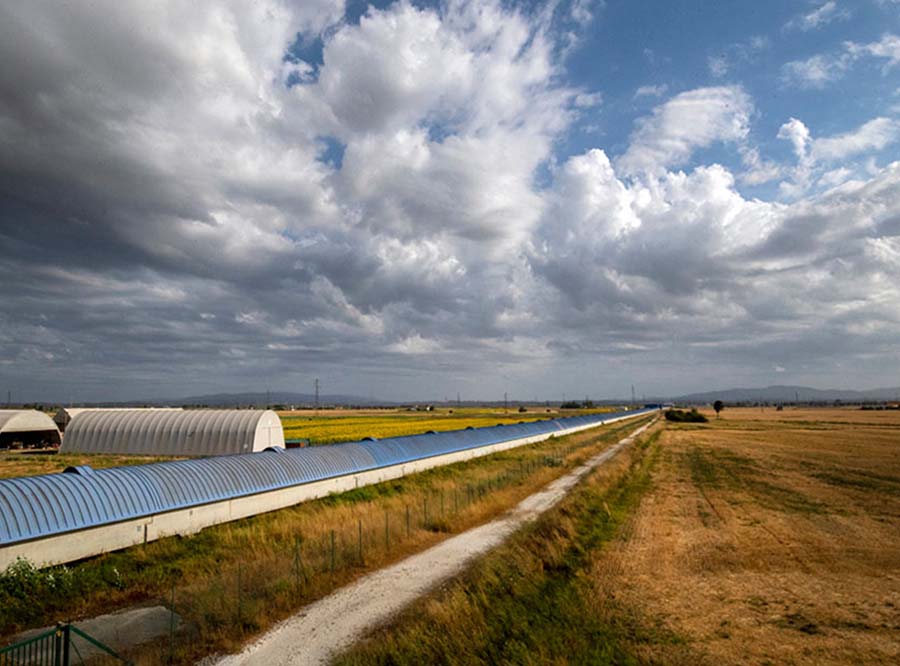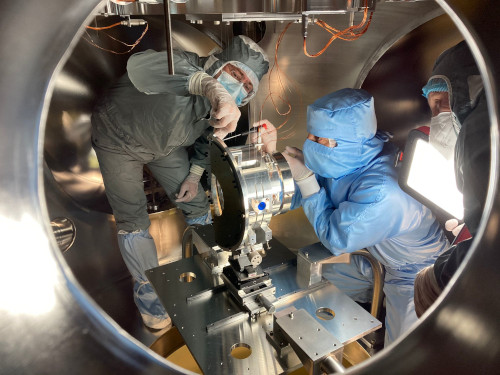Fighting Noises

The high sensitivity that Advanced Virgo needs to achieve for observing the tiny space-time variations induced by the passage of gravitational waves through the detector represents a real challenge. On the one hand, Advanced Virgo is designed to maximize its response to a gravitational-wave (see Optical Layout). On the other hand, numerous noise sources need to be eliminated or at least largely suppressed. These include: the thermal motion of the atoms constituting the mirrors and the fibers they are hung to; the laser frequency, power and pointing jitter; the air molecules present in the path of the laser beam; the thermomechanical deformations induced by the absorbed laser power; the imperfections in the optical quality of the mirrors; the electronic noise of photodiodes and electronics; the sensor and actuator noises for the many feedback systems required to keep Advanced Virgo at its working point; the fundamental noises of the light itself as described in Quantum Mechanics…
Furthermore, the natural environment which Advanced Virgo is part of is on its own a source of noises which need to be filtered: the seismic motion of the ground, the bad weather, electromagnetic noises or even the changes in the local gravitational field due to motion of masses around the Virgo mirrors, and others. Increasing the signal and reducing all noises, or, as the scientists say, maximizing the signal-to-noise ratio, is a tremendous challenge: the actions towards this goal shape Advanced Virgo and make it extremely complex and fascinating.
Seismic noises

Virgo sits on the ground and that ground is moving all the time. Humans only experience this in case of earthquakes, but this permanent shaking is a concern for the detector, given the accuracy with which the position of its mirrors needs to be controlled. To reduce it drastically, the Virgo mirrors are suspended via a long chain of pendula, hosted in towers 10-meter tall, the Superattenuators. Their combined effect is such that the amplitude of the ground motions which have a periodicity of 0.1 second or lower (a frequency of 10 Hz or higher) is reduced by a factor in excess of 1012, which is more than a thousand billion times! These Superattenuators are not just passive attenuators: they are also used to actively control the position of the mirrors. At lower frequencies (larger periods), these systems reject less and less seismic noise, whose contribution becomes dominant. This explains why current ground-based GW detectors are said to be unable to detect signals whose frequency is below about 10 Hz. This “seismic wall” is a fundamental limit for all these instruments – although future projects, e.g. 3rd generation underground Einstein Telescope, are planning to shift that limit down to a few Hz. Launching detectors in space (like the LISA project) is the only way to get rid of it.
Violent Earthquakes
Strong enough earthquakes (where the effective strength depends on the earthquake magnitude and on the distance of its epicenter from the Virgo site) stress the Virgo control system, such as the working operation point can be lost and the data-taking interrupted. Such breaks can last long: prior to re-acquiring the control of the whole detector, one may have to wait for the excitation, created by the abrupt loss of control or directly by the excess seismic noise, to be damped.In order to estimate whether a given earthquake could overcome or not the control of the detector and in order to minimize the possible interruption, Virgo is receiving early warnings from the US Geological Survey (USGS). For earthquakes which are far enough from EGO, the warning is indeed “early”, meaning that it is received before the seismic waves have arrived on site. While there is no way to shield the detector away from these, this extra delay can be used to mitigate the effect of potentially strong seismic waves. In addition, a collaboration with the Italian Istituto Nazionale di Geofisica e Vulcanologia (INGV) should lead to the use of a second earthquake early warning system, to supplement the USGS one. This will provide a more complete coverage of the earthquakes and should allow to receive earlier the earthquake alerts for those which are close to Italy and hence to Virgo.
Bad weather

Another source of disturbance for the Virgo detector is bad weather, namely high winds and intense sea activity: the waves hitting the Tyrrhenian shoreline produce seismic noise that propagates to the EGO site, about 10 kilometers away. This tremor of the Earth’s surface is well-known by geophysicists and called a sea microseism. High sea activity periods correspond to a lower sensitivity of Virgo due to higher seismic noise at the site. Moreover, sea microseisms induce short transients of noise (glitches) that impact the quality of the data and produce signals which may be misinterpreted as gravitational waves (false alarms). Sea microseisms can also affect detector components in general, increasing for instance the noise due to scattered light, reducing the accuracy of the detector control and hence its sensitivity to gravitational waves.
Lightning strikes can also disturb Virgo: both as an electromagnetic interference and, at a delayed time, as sound pressure waves which induce vibrations of the ground and of the detector’s mechanical components.
Thermal noise
Thermal noise is a whole class of noises linked to the random thermal agitation of the atoms and molecules constituting all the pieces of the detector: the greater the temperature and the mechanical losses, the larger is such agitation and hence the noise. Virgo works at room temperature and the main strategy to reduce the thermal noises is to employ very high quality materials, with low internal friction. The main thermal noise limiting our sensitivity is coming from the mirrors and their suspensions of the long arm cavities: the induced effect is a random vibration of the mirror surface which could mask the GW signals.
Not only the mirrors and their suspending fibers are made of a material with intrinsic low thermal noise but also large laser spots are preferred: this helps in reducing the effect of the thermal noise by averaging the random vibration of the mirror surface over a large area of measurement. For next generation detectors, the mirrors will also be cooled to cryogenic temperatures.
Quantum Noise
At the impressive sensitivity levels of an interferometric detector such as Advanced Virgo, the quantum nature of light sets the ultimate limit. In the quantum realm, light can be thought to be made up of a stream of discrete energy packets, the photons. They are ‘counted’ by the photodetectors used to measure the light power, and they also push on the mirrors they are reflected off. Correspondingly, since the photon stream fluctuates, two noise contributions are generated: the photon counting noise (or shot noise, dominant at high frequency) and the radiation pressure noise (dominant at low frequency); collectively, they are referred to as quantum noise.
These two noise sources scale inversely with the laser power: the shot noise is reduced using a more powerful laser, while the radiation pressure noise goes up with that same power. Therefore, one must find a balance between these two effects to minimize the impact of their combined noise on the sensitivity of the detector – that should ultimately be good, both at low and high frequencies. For a given frequency of the gravitational wave one wishes to detect, there exists an optimal laser power which minimizes the combination of these two noises. This situation of balance between the shot noise and the radiation pressure noise is called the Standard Quantum Limit.
Vacuum System
The vacuum system is a critical part of the Virgo infrastructure. All the most critical components such as the arm mirrors, the beam splitter and the recycling mirrors are hosted inside vacuum towers to remove the noises due to the presence of air molecules. For the same reason the laser beams are propagating in vacuum: the vacuum chambers hosting the main optics are, hence, connected by vacuum pipes where the laser beam is circulating. The largest tubes of Virgo, that link the two towers of the Fabry-Perot cavities are 3 kilometers long and 1.2 m in diameter. The pressure of the residual gas needs to be extremely low, about a thousand billion times less than normal atmosphere! This makes Virgo a huge, ultra-high vacuum chamber of 6800 m., that is actually the largest ultra-high vacuum system in Europe.
To attain this very low value, the stainless-steel pipes have been built following a special metallurgical process involving hydrogen desorption at 400°C; moreover, once installed and after initial vacuum was pumped, the pipes have been heated to 100°C for several days to eliminate the water molecules sticking to the metal surface. Finally cryogenic traps are installed at each end of the tubes to stop the migration of water molecules from the unbaked towers to the tubes.
Optical losses and thermal compensation system
As the principle of detection of GW is based on light, losing light in the detector equals losing also part of the GW signals. As such the optical losses are critical in the experiment and must be contained to a very low level.
Not to lose light we must first only use state-of-the art optics with outstanding performances. The optics are made with the best available glass, one which is totally transparent and free of defects. The polishing is made at the atomic level to have a surface perfectly smooth, which scatters light minimally. Finally a special coating is added to reflect more than 99.999% of the laser light.
The whole process of manufacturing the optics and installing them in Virgo needs to be done in clean rooms, to avoid dust and other contaminants. In Virgo, even with the excellent optics, some residual optical absorption still exists (in the order of few parts per million). This very small absorption in conjunction with the very large circulating laser power (more than 100000 Watt of light in the arms) can still have some detrimental effects on the operation of the detector. So to compensate for those effects, a system of thermal compensation has been implemented which can change in time the shape of some optical components: it is like adding corrective glasses to some optics to restore the best operation of the machine.
Scattered Light Noise

For the experiment to work properly, the Virgo laser beam should follow a well-defined path and have the spatial properties expected from the design. However, some light still leaves the main path at various locations and is scattered in other directions. This can be due to the residual roughness of the smooth surfaces of the optics, or an effect of the interaction of the light with imperfections in the bulk of transmissive optics, or even due to dust stuck on some optics even if hosted in the clean environment of Virgo. Light can also be scattered by the residual gas molecules present in the Virgo vacuum chambers and pipes and which interact with the main laser beam. Light propagating into unwanted directions can also be caused by residual transmission or reflection from optics. Scattered light can be harmful if it later recouples with the main interferometer beam after being reflected by some vibrating structures: this causes additional noise which can then either mimic a gravitational wave signal, or spoil control signals needed to keep the working point of the Virgo detector. To fight against stray light, Virgo employs very high quality, low losses optical components, makes the laser beams propagate in vacuum, and adds light absorbing plates close to all the suspended mirrors as well as inside the vacuum pipes of the Virgo arms and on the benches supporting the optics which are hosted in clean rooms.
Newtonian Noise

Newtonian Noise is one more possible noise source that affects a gravitational-wave interferometer like Virgo. This noise originates from time-dependent local changes in the gravitational field close to the mirrors of the interferometer arms: these local changes generate a Newtonian interaction (i.e. described by the classical theory of gravity) that moves the mirror, thus disturbing the detector sensitivity to gravitational waves. Local changes of the gravity field can for instance be caused by density fluctuations propagating in the soil surrounding the detector and due to seismic waves. Atmospheric density perturbations are also causes of Newtonian Noise: they can be generated for instance by pressure waves (in the infrasound region) and by temperature fluctuations. In geophysics, these fluctuations are of great interest because they carry information about processes such as fault ruptures and atmospheric density perturbations.
The Newtonian Noise source is relevant at low frequencies, i.e., it impacts our capability of detecting GWs with frequencies between about 1 and 20 Hz. Newtonian Noise is a direct interaction of the environment with the detector: no filter can be put in place to cancel its effect.
The main strategy adopted to mitigate Newtonian Noise is to monitor the local gravitational field perturbations using an array of strategically-disposed sensors, such as microphones and seismometers, and then subtract the measured Newtonian Noise from the data. Advanced Virgo will implement such a scheme during the next observing periods.